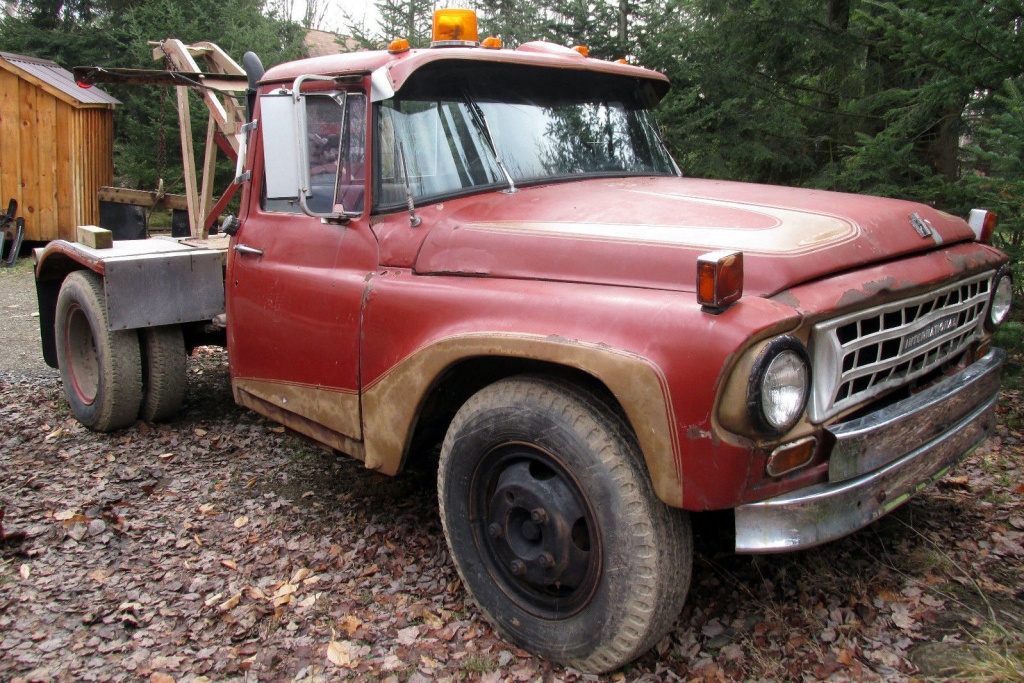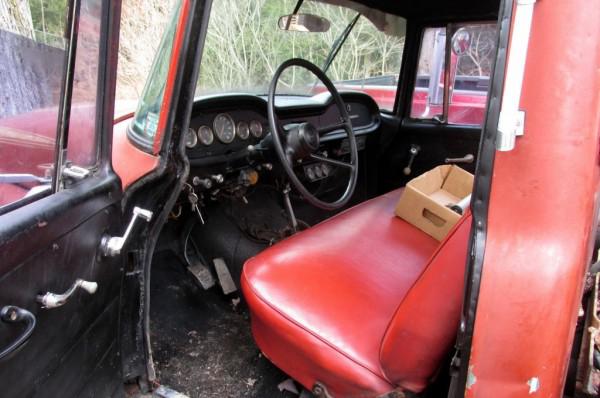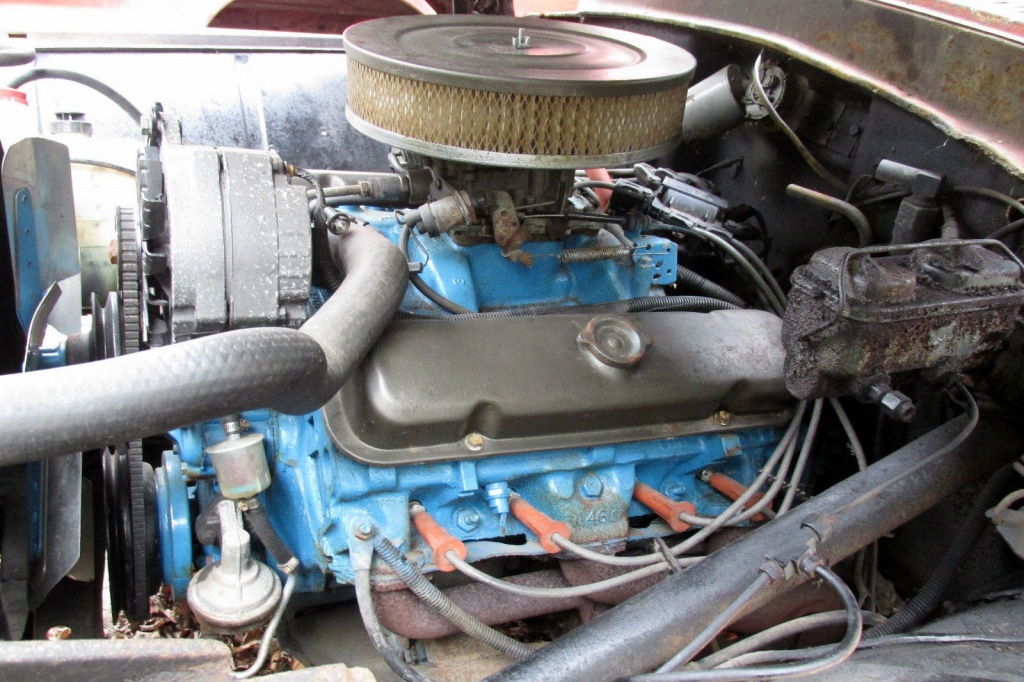I have a tow vehicle and a trailer with a winch for towing home my barn finds… or the race car when it breaks, or the Triumphs when the Prince of Darkness strikes! I’m looking at this wrecker and thinking how nice it would be to be able to just hook up and go home! Typically when I need to tow a car home, it’s either in the middle of the night, or I’m tired—the last thing I want to do is get a trailer out of storage, hook up a tow vehicle and head out, then spend half an hour pulling the dead car onto the trailer and tying it down. If you feel the same way, check out this wrecker located in Holland, New York and up for auction here on eBay with no reserve and a buy-it-now of $2,995.
My wife took one look at the pictures and said “it’s Mater!” Not really, but the patina is sure there with this one. As the winch and tow mechanism is claimed to be functional, although needing electrical sorting, this would be a perfect minor project for my garage. I wouldn’t change a thing cosmetically with the exception of adding some period lettering to the doors, aged appropriately of course. The dual wheels (and dual stacks) lend a sense of purpose to the wrecker that would be difficult to emulate with a modern vehicle.
Apparently someone considered a radio too much of a luxury—I think a period AM radio would fit the image perfectly (but I’d hide a modern one somewhere else). The seat looks serviceable, and I’m usually covered with grease and dirt after I give up on repairing whatever broke anyway, so old vinyl works just fine and will wipe clean after I get it greasy. The NY state inspection dates from 2004, so it’s been off the road for a while, although the seller states that it runs, steers, and brakes. As a matter of fact, the seller has included a video of the truck running, and it sounds pretty good!
And this 400 cubic inch Pontiac V8 is what’s making it sound so good. The seller doesn’t tell us how this got here (as opposed to the original engine) but it looks like a nice clean installation. I am wondering, though, about the brake modification visible here where it looks like one half of the master cylinder has been bypassed. Brake operation would have to be checked, and I’d rather utilize the dual-circuit capability for safety purposes. That doesn’t sound like a difficult fix, though. So, would you like to have your own Mater? I sure would!










Love old Trucks of any kind. Good Find.! Engine looks nice and well maintained. A sure winner..
Looks to be in fairly good shape. That isn’t a ’66 grill but then, the engine isn’t original either. I wouldn’t want to speculate on why the stock engine got replaced with a Pontiac unit as IH engines are well built and last a long time. It looks like an automatic got put in as well (automatics were available in light IH trucks but I never saw one in a 1-ton); I would’ve expected a Spicer or Warner 4 spd. If I got it I’d be dropping in a 304/4spd.
The main reason International Harvester is no longer around is because they knew nothing about ergonomics. Their vehicles had to be the most uncomfortable vehicles to drive ever. Their designer must have been a chimpanzee clone – if they even had a designer.
The fact that they survived so long likely had to do with their customers being equally unschooled in ergonomics. Since the main customers were farmers and fleet owners, the farmers didn’t talk to each other much so it took a long time for the discomfort of being in an International anything to get around. Buying agents for fleets look for economics and reliability which goes back to economics. The sheer awkwardness of driving one of these goofy things was never a consideration.
It’s only when you get stuck driving one after learning the comforts of better designed relationships between steering wheel, seat and pedals that you come to appreciate the fine degree of design ignorance that went into these rolling junkyards.
And yes I was stuck driving these hunks of junk and every minute was a minute too long.
If you take a close look at the relationship of the pedals to the front of the seat in the interior shot you can see what I mean. The pedals are way too close to the seat. If you move the seat back you find that by the time your legs are comfortable, you’re too far away from the steering wheel.
Hi John. In some ways I might agree with you as far as the ergonomics are concerned. But on the farm, we had (2) grain trucks: a ’57 IH A160 and a ’61 GMC 960. I drove them both and have to say that the ergonomics left something to be desired in both. I’d say that IH’s decline in the light truck department was more in ’69 when the designers decided to shape the trucks like a brick. My dad had a ’69 1200 crew cab and while it wasn’t all that bad to drive, it looked horrible. The A & B light trucks’ handling left a lot to be desired but the big trucks were OK.
.
You ( and your cars ) will be a lot happier with a ramp truck for about 5000.
TOWING requires reliable rear tires on the car being towed… also often requires driveshaft drop….. and always requires LOTS of considerations while towing ….maybe these are generally called “wreckers” because often,. that is what they do, when in the hands of inexperienced operators……….or because they are best suited for moving ‘wrecked’ cars
.
A 5k ramp truck is a much better option
.
Dave, I agree…the idea of towing stuff home was largely tongue-in-cheek :-) Although there are times….
radio??? You aren’t gonna hear no radio over the racket this thing would make going down the road.
I had a scout,really in good condition,that motor ran SO well,the front end had death wobble.blew the rearend,had it profesionaly rebuilt at a big truck repair shop,blew it up again.Had it repaired at the IH dealer,blew up again.I personaly towed it to the Junkyard myself.motor still ran beautifuly. Then later I got a 1 ton four wheel drive,like this truck shown,blew up the rear end.And that was the end of my love afair with cornbinders
DT, too bad about the problems you had. The axles in almost all these ‘Binders were pretty much standard Dana axles (30 front in early scouts, 44’s F&R in later scouts and the truck line, 60’s and 70’s for rear axle in the 3/4 on up trucks, etc…..for the most part). Pretty much most of the other 4wd drive vehicles of the day had Dana axles, so IH had little to do with the issues you had. What was going on that you puked so many? Previous owners abuse? Just curious as they tend to be pretty bullet proof if filled with fluid and not abused. I’d be pretty off a brand to if I had that many issues!
Probably me,But Ive had my 1964 3/4 ton 4wd Chevy panel truck since 1977, Only 2 rear ends so far. original finaly failed from old age and the second one was used ,but I still got 100,00 miles out of it before it broke,now Im on # 3 but its very good
Yes, mostly Dana differintals, I have seen problems with early Scout diffs becuse of the torque of the IHC engines. I had a high school teacher that was not much of a machinry guy, he would get his old Scout out hunting, invariably wind up in low range 4X4 and either twist off the drive shaft or break the rearend. I we changed so many of them it got pretty easy. I always chalked it up to operator error. I have owned maby a dozen of them and never had any trouble with the differintals. I did have a 1979 Traveler that had really poor road handeling. It would just not go straight down the road, I rebuilt and changed everything to no avail. I think the power steering gear was too fast……never could get it comfortable to drive.
The best thing about this truck is the Pontiac engine. After that it would be scrap metal unless you’re into self-abuse and really need this truck with no other options available.
I have owned these trucks for over 40 years. They were the best on the road but you need to be smart enough to understand them. Every one is custom built, most for a specific type of work. My first one was a 1963 that my grandfather bought new for use with a camper. It had high gears, power steering, power brakes and a 8 1/2 foot bed specially designed for a camper, it had a 304 IHC V8 that would get over 16 MPG on the highway with a 10 foot cabover camper. The International V8 engines are nearly all interchangeable, they used the same engines in trucks up to 5 ton trucks, they had forged steel crankshafts, sodium cooled valves, were highly balanced. The biggest trouble was the cost of repair was high compared with lesser automotive engines. So, an IHC designed for field work did poorly on the highway and visa versa. There was a huge number of options available, everything from Perkins Diesel engine to auxillery transmissions giving you 20 gears to choose from. iHC was one of the first manufacturers to build a factory 4X4 pickup, crew cab pickups, they were an early proponent of Positraction rear ends, Many parts were common with other makes, Dana rear ends were common as were Delco electrics, New Process transfer cases and transmissions, . and Holly Carbs. International moved away from the light truck market in the late 80’s becuse they could not compete in the market with more car like trucks like Chevrolet, Ford and Dodge. They still are the largest truck manufacturer on the planet and as we know still build some of the best engines used on other brand trucks. The pickup line was a large truck made small, not a car made into a truck
There’s a reason you don’t see these old sling-type wreckers much any more: Just about any vehicle built after about 1950 has a pretty fair chance of being severely damaged by an inexperienced operator that hasn’t taken the time to learn how to use blocks of wood to avoid destroying bumpers/sheet metal/core supports. And don’t even get me started on suspension damage from those J hooks. I operated a Ford wrecker of similar vintage for a VW dealer in the early ’70s and it was a challenge every time I got sent on a call. The wheel lift wrecker is the most important advance in auto recovery in the last 100 years…
Jamie here’s one you might like, this isn’t mine, I’m just passing the info. along:
5K
http://lakecharles.craigslist.org/cto/4901779309.html
“75 Chevy crew cab truck,wedge bed car hauler. 60k miles on small block 400 with turbo 400 trans.”
All the best and keep looking, Robert R.
Wow, that’s a nice setup! Thanks, Robert :-)